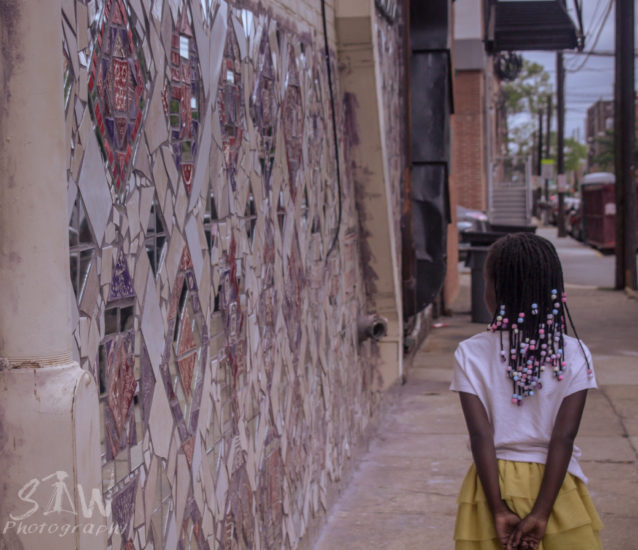Delaware Art Museum’s Public Art Stewards Program cares for community treasures while teaching career skills
By Emily Sortor
If you have noticed that Wilmington’s public art has been getting extra attention lately, you aren’t alone. Delaware Art Museum Curatorial Project Manager Benét Burton and conservator Margalit Schindler have been spending quality time in Wilmington’s outdoor spaces, recording information about murals, statues, memorials, and more.
They are preparing for the launch of a six-month pilot of the Delaware Art Museum’s Public Art Stewards Program. The initiative will invite six to eight community members to learn how to clean, maintain, and document 30 public artworks throughout the city. The program will offer coaching not only in public art maintenance, but in general jobs skills that will help the stewards in whatever career path they may choose.
Combining public art and workforce development has a long history in Wilmington, explains Delaware Art Museum Chief Curator Margaret Winslow, who envisioned the Public Art Stewards Program. Wilmington boasts more than 150 works of public art, many of which were funded by governmental grants used to stimulate the local economy when times were tough. When the city received COVID-19 relief funds, Winslow saw an opportunity to once again pair workforce development with public art. She knew this time around, the city needed care for its existing artworks more than it needed new ones.
“Historically, public art commissions have not incorporated the restoration and maintenance of a project, says Winslow.”
As a result, much of Wilmington’s public art was looking the worse for wear.
Fortunately, a way forward was right in Wilmington’s backyard. Delaware’s own Winterthur Museum, Garden, and Library offers one of the country’s best art conservation programs, where students learn to care for and preserve artwork for the future. When they learned of the Public Art Stewards Program, Winterthur conservation alumni Margalit Schindler was ready to come onboard to share their organization’s conservation knowledge with the stewards.
Winslow says the field of art conservation has grown in the last 15 years, and with it, so has the interest in maintaining public art across the country. When the stewards learn to clean and maintain public art, they are opening the door to a marketable skillset.
“I’ve had this program in mind for about five years,” says Winslow. “The pandemic emphasized economic disparities, which led to a push for workforce development. The need for gainful employment really came to the forefront.”
The time was ripe for the program to be developed.
Thinking how to best use community development funds, Delaware Art Museum turned to a longtime community partner: Creative Vision Factory, a local nonprofit that supports individuals on the behavioral health spectrum and has been a part of creating some of Wilmington’s public art works. The two organizations determined that the Public Art Stewards Program should benefit Wilmington community members who are traditionally underserved.
So, starting this month, the program will be inviting applications from Black and Indigenous community members who are navigating economic precocity and who are on the behavioral health spectrum. Creative Vision Factory has agreed to stay on board for the Public Art Stewards Program, helping to shape the job training curriculum in response to what community members share that they want and need.
Winslow and Burton are excited about how the Public Art Stewards Program can benefit the stewards, the art, and the community at large. The Delaware Art Museum positions Wilmington’s public art as an “outdoor gallery” that offers enriching art experiences to everyone, regardless of whether they spend time in museums.
While taking stock of Wilmington’s public art, Burton was struck by the wealth of knowledge shared by folks throughout the city. Listening to community members share memories of the art around them helped her piece together the histories of the works.
“Ideally, we would make the information we are learning publicly accessible and would do programs to let the community engage with the works in their space. I’d like to create a living archive,” says Burton.
At the same time, she stresses that even Wilmingtonians who do not know the histories of the works still have relationships with them.
Burton smiles as she reflects on the interactions she has had during her research. She explains that passersby are often curious when they see two people intently studying a work of art in the middle of the workday. In these moments, people have a range of reactions.
Sometimes they worry about what is happening to the art. Sometimes they notice the work in a new way. Burton invites the curiosity and the conversation.
“It’s great to see that community members feel ownership over the public art, and that they have a connection to it,” she says.
Burton hopes the Delaware Art Museum’s Public Stewards Program builds on this existing sense of connection and ownership, and will enable more people to forge a relationship with public art.
— To ensure that Wilmington’s public art is around for generations to come, Winslow and Burton hope the pilot program will not be the last of the Public Art Stewards Program. They envision ways for the program to scale, should funding allow. After the first 30 works are restored, they aim to train more stewards to clean and maintain more of Wilmington’s 100+ artworks. They are eager to share what they learn with other arts institutions and other communities, so that similar programs might be created elsewhere.





